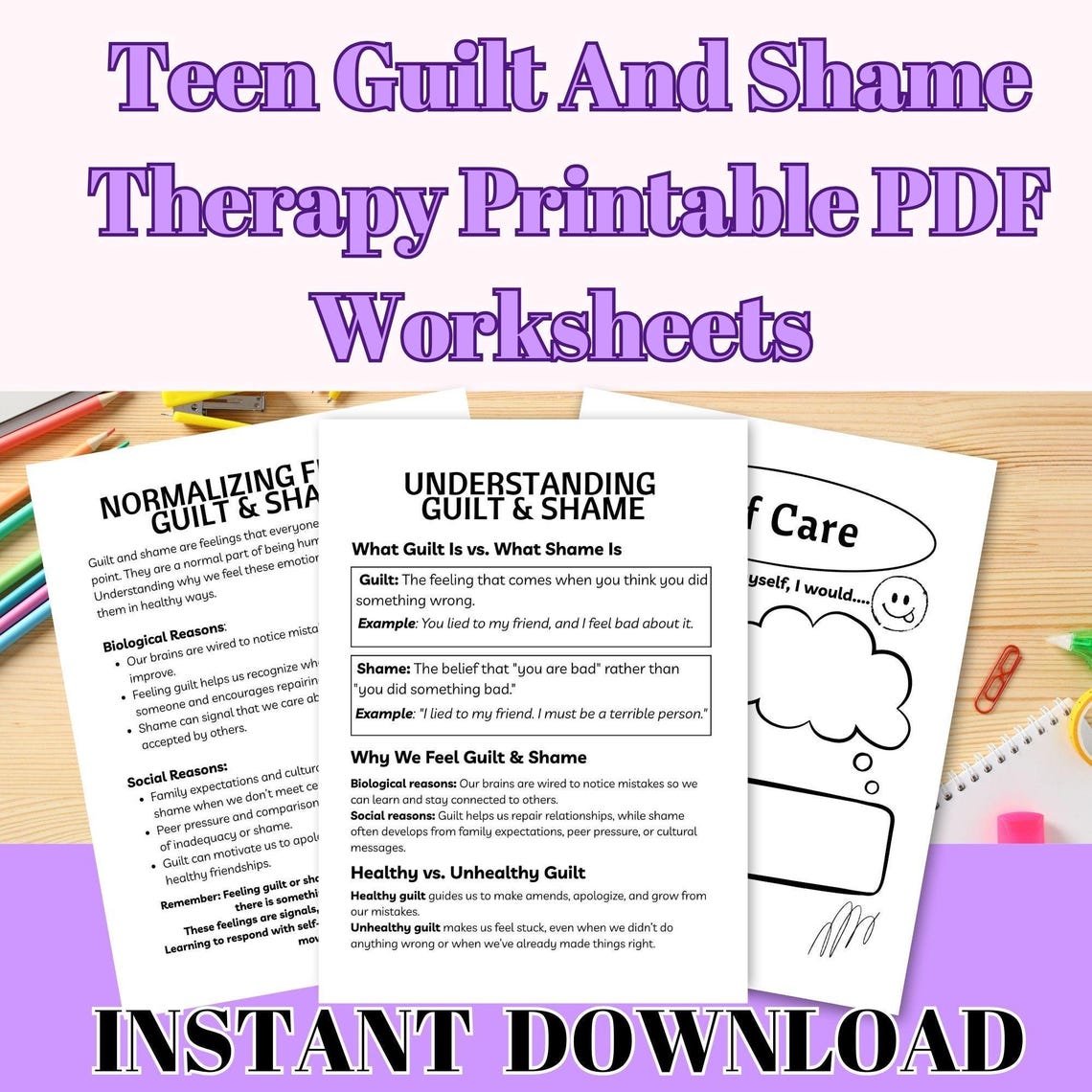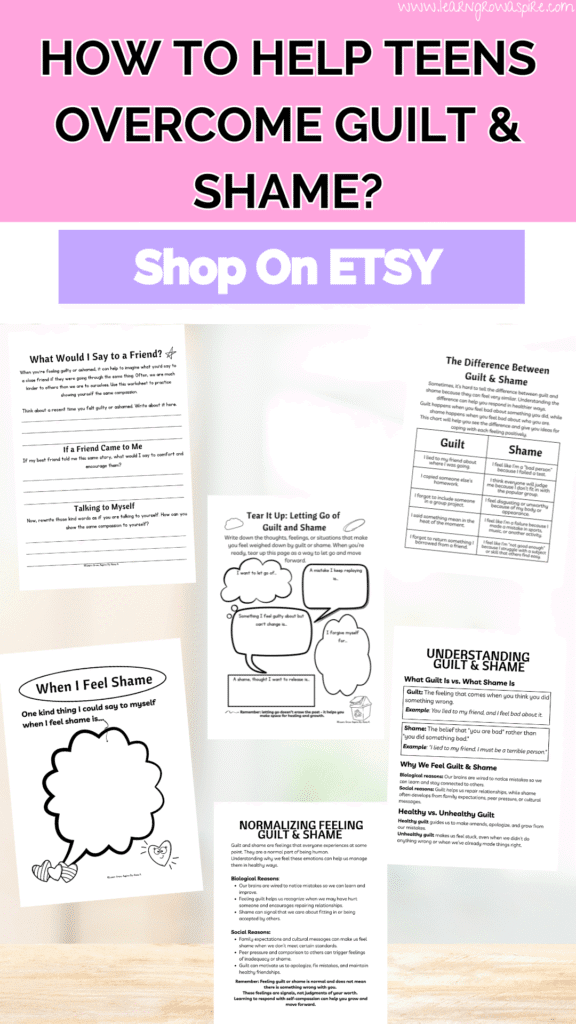Guilt and shame are two powerful emotions that every teen experiences at some point in their teens. While they can serve as valuable guides for growth and responsibility, when left unchecked, they often lead to self-doubt, low self-esteem, and negative coping strategies. As parents, teachers, and counselors, one of our most important roles is helping teens overcome guilt and shame in a healthy and constructive manner.

In this post, we’ll explore the differences between guilt and shame, their impact on teenagers, and practical strategies to support them.
I’ll also share a printable packet of teen guilt and shame worksheets that you can use right away to help guide meaningful conversations and self-reflection with your teen.
You can find it here: Teen Guilt and Shame Printable Worksheets.
Understanding Guilt vs. Shame
Before we dive into strategies, it’s important to understand the difference between guilt and shame.
Guilt is the feeling that comes from recognizing we’ve done something wrong or hurtful. For example, “I feel bad because I lied to my friend.” Guilt focuses on behavior and can motivate positive change.
Shame, on the other hand, is the belief that there is something wrong with us. For example, “I lied to my friend, so I must be a terrible person.” Shame attacks the self, not the action, and often leads to withdrawal, secrecy, or self-criticism.
Teens often blur the line between these two emotions, making it harder for them to distinguish between mistakes and identity.
Our job as their guidance is to help them see that they can take responsibility for their actions without labeling themselves as “bad” or “unworthy.”
Why Guilt and Shame Hit Teens Hard?

The teenage years are marked by identity exploration, peer pressure, and emotional fluctuations.
Here are a few reasons guilt and shame can feel overwhelming during adolescence:
-
Developing Identity – Teens are figuring out who they are, so they often internalize mistakes as character flaws.
-
Peer Pressure & Social Media – With constant comparison, even small mistakes can feel magnified.
-
High Expectations – Academic, family, and social pressures can leave teens feeling they’ll never measure up.
-
Lack of Coping Skills – Many teens haven’t yet learned how to reframe negative thoughts or practice self-compassion.
When guilt and shame become too heavy, they can contribute to anxiety, depression, or avoidance behaviors.
That’s why teaching healthy coping skills is essential.
Healthy Ways Teens Can Work Through Guilt and Shame
Helping teens overcome guilt and shame requires patience, empathy, and practical strategies.
Here are some approaches you can start using today:
1. Encourage Open Conversations
Create a safe space where teens feel comfortable sharing their feelings without fear of judgment. Sometimes just being heard can reduce the intensity of shame.
2. Separate Actions from Identity
Remind teens that making a mistake doesn’t define who they are. Saying, “You made a mistake, but that doesn’t mean you’re a bad person,” helps shift their perspective.
3. Teach Self-Compassion
Encourage teens to treat themselves the way they would treat a friend in the same situation. Ask: “If your friend messed up, what would you say to them?”
4. Model Healthy Coping
Teens often mirror the adults in their lives. If you talk openly about mistakes you’ve made and how you’ve worked through them, you normalize the process of growth and self-forgiveness.
5. Use Structured Reflection Tools
This is where worksheets and guided activities become so powerful. Structured prompts help teens identify triggers, reflect on their experiences, and practice healthier thought patterns.
Why Worksheets Work So Well for Teens?

Many teens struggle to express emotions verbally, especially around sensitive topics like guilt and shame. Worksheets provide a non-threatening way to explore difficult feelings. Writing down thoughts allows them to:
-
Organize overwhelming emotions.
-
Identify patterns of guilt and shame triggers.
-
See progress over time as they practice reframing.
-
Develop problem-solving skills instead of bottling emotions.
That’s why I created a Teen Guilt and Shame Printable Packet – to give parents, teachers, and counselors simple, effective tools to help teens work through these tough emotions.
Inside This Teen Guilt and Shame Packet
I’ve designed this printable resource specifically for middle school and high school students. Each worksheet encourages self-reflection, writing, and practical strategies for building resilience.
Here’s what’s included:
Tear It Up Page – Teens write down negative self-beliefs and literally tear the page to release those harmful thoughts.
Reflection Prompts – Guided questions to help teens reframe negative thinking patterns.
Shame Writing Prompts – Open-ended prompts that encourage healthy expression and processing.
Self-Compassion Exercises – Activities that teach teens to replace self-criticism with supportive inner dialogue.
These worksheets can be used in classrooms, therapy sessions, or at home as part of a teen’s personal growth journey.
👉 You can grab the full set here: Teen Guilt and Shame Worksheets Packet.
Practical Tips For Using the Worksheets
Start Small – Introduce one activity at a time instead of overwhelming teens with the whole packet.
Give Space – Let them work independently, then invite them to share if they feel ready.
Pair with Conversation – Use completed worksheets as conversation starters.
Normalize Mistakes – Remind them that guilt and shame are universal human experiences.
Celebrate Growth – Encourage them to notice changes in how they respond to difficult emotions over time.
Supporting Teens Beyond Worksheets
While worksheets are powerful, they work best alongside consistent emotional support.
Here are other ways to help:
-
Encourage journaling, art, or creative outlets.
-
Promote healthy routines like exercise, rest, and balanced nutrition.
-
Model forgiveness by showing how you let go of your own mistakes.
-
Seek professional help if guilt and shame seem overwhelming or persistent.
Remember, healing is a process.
Every step your teen takes toward understanding and self-compassion is a step toward stronger mental health.
Helping Teens Overcome Guilt and Shame
Guilt and shame don’t have to define your teen’s self-image.
With the right tools, they can learn to separate mistakes from identity, practice self-compassion, and build resilience for the future.
If you’re looking for a simple, ready-to-use tool to guide your teen through this process, I encourage you to check out my Teen Guilt and Shame Printable Worksheets Packet.
It’s a powerful resource for parents, teachers, and counselors who want to give teens practical strategies for working through these emotions.
👉 Get your copy here: Teen Guilt and Shame Worksheets Packet.
Helping teens overcome guilt and shame is not just about easing their struggles today; it’s about equipping them with lifelong skills for self-awareness, resilience, and emotional well-being.
More Teen Emotional Well-Being Resources
Here are some more emotional well-being tips and resources you may want to check out for your teens:
- 7 Powerful ways to support teens’ mental health
- Confidence-building worksheets for teens
- Anger management worksheets for teens
Pin These Teen Shame & Guilt Activities
Make sure to save these Helping Teens Overcome Guilt and Shame activities to your teens’ therapy Pinterest board so that you can easily find them when needed. And while on Pinterest, please consider following me on the platform. I will truly appreciate it.

Some of the links in this post may be affiliate links. I’m also an Amazon Affiliate and will occasionally link to some of my favorite Amazon products. I will receive a small percentage back if you purchase through my link. You won’t be charged a penny more if you shop through my links. That said, I do NOT recommend anything I do not use and love! Thank you for helping support my blog!

Leave a Reply